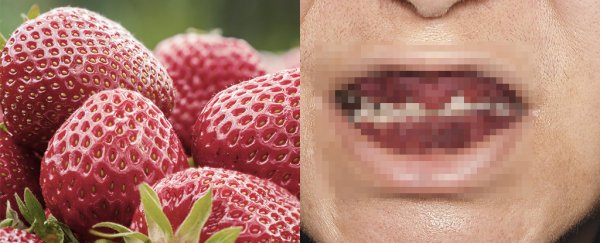A rare manifestation of a very rare disease ended up giving a woman's swollen, overgrown gums the appearance of strawberry flesh, in what doctors describe as a severe and extreme case. WARNING: there are graphic images of this case below.
A case report details the strange symptoms experienced by a 42-year-old woman in Iran, who presented at a dermatology clinic, explaining that for about six weeks she had been experiencing a rapidly worsening and painful case of gum overgrowth.
This condition, called gingival hyperplasia, was accompanied by recurrent nosebleeds, and three necrotic ulcers that had developed on her face in the space of the previous month.
 (M. Ghiasi, NEJM, 2017)
(M. Ghiasi, NEJM, 2017)
When doctors examined the patient's mouth, they observed her case of gingival hyperplasia was so pronounced it had developed into a particularly rare form of gum enlargement known as 'strawberry gingivitis', with its distinct "granular and haemorrhagic appearance", as dermatologist Maryam Ghiasi from the Tehran University of Medical Sciences explains in the case note.
"I think you can figure out why [it's called strawberry gingivitis]," says Michigan-based periodontist Joseph Nemeth, who wasn't involved with the patient's episode or treatment, but discusses the case in the video below.
"The tissue can look like strawberries. However, it's a symptom of a very serious vascular or blood vessel disease."
That disease – called granulomatosis with polyangiitis (sometimes known as Wegener's Granulomatosis) – is a type of inflammation of the blood vessels that usually affects the upper respiratory tract and the kidneys.
In this instance, the patient was diagnosed with the condition, not just because of her remarkably swollen gums and facial sores, but also due to certain antibodies that were present in her system, together with the existence of multiple growths called pulmonary nodules in her lungs.
"Strawberry gingivitis is a rare manifestation of granulomatosis with polyangiitis, and its clinical presentation is highly suggestive of the disease," Ghiasi writes.
While the physical symptoms the patient was exhibiting were already extreme, it's possible things might have gotten even worse if she hadn't visited doctors when she did.
"Very often this disease if not caught early can be fatal," explains Nemeth.
"And sometimes, the dental surgeon, the dentist, the periodontist, sometimes we're the first ones to actually see something like this because the patient may not be aware of symptoms other than what's going on in their mouth."
Sadly, in this case, we don't actually know what became of the woman.
Doctors administered a treatment including the synthetic steroid prednisolone and an immune suppressor drug called cyclophosphamide that is sometimes used in chemotherapy.
The case, which was reported back in 2017 – and recently resurfaced in online news reports – is something of a mystery. After the 42-year-old patient commenced her treatment, she was lost to follow-up, so her doctors don't know whether her condition was successfully treated.
In any case, the unsettling appearance of her oral symptoms – and the dangerous disease that caused them – stand as a timely reminder never to ignore anything unusual you notice in your mouth.
"This was a fascinating case and this photograph is the most severe one that I have seen," Nemeth says.
"A blood vessel disease can be treated if caught early, but if not, it can be fatal. Make sure your mouth is checked, not just for cavities, not just for gum disease, but a general look-over, because there's lots of things that we can catch first in the mouth that may otherwise be missed."
The findings are reported in The New England Journal of Medicine.
